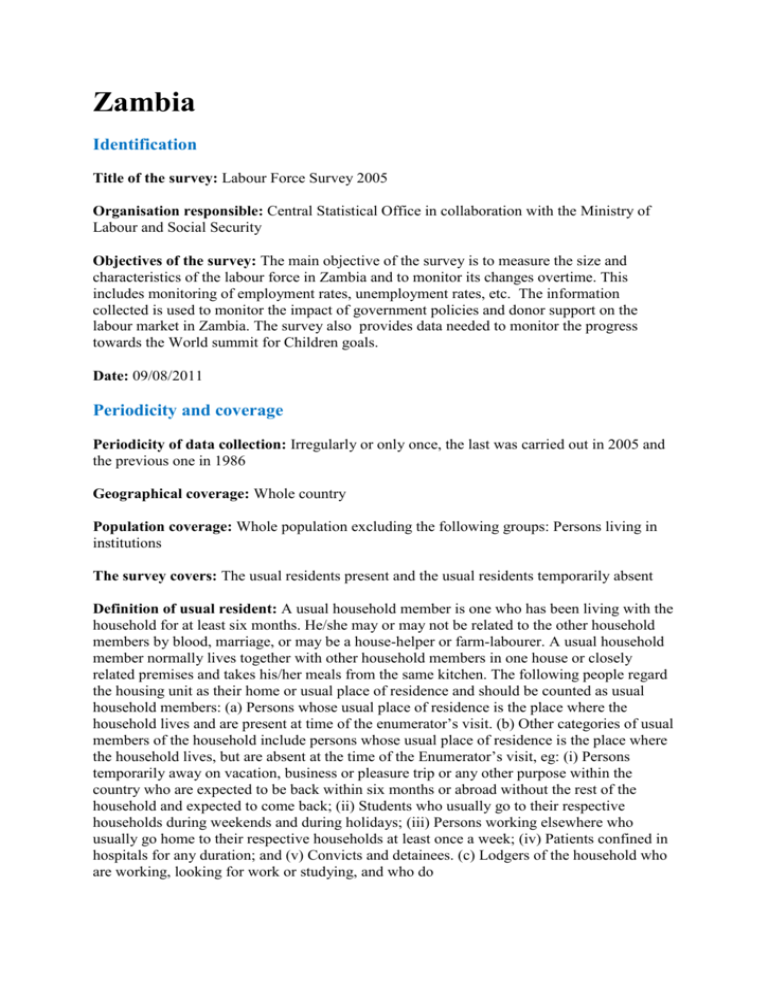
Zambia
Identification
Title of the survey: Labour Force Survey 2005
Organisation responsible: Central Statistical Office in collaboration with the Ministry of
Labour and Social Security
Objectives of the survey: The main objective of the survey is to measure the size and
characteristics of the labour force in Zambia and to monitor its changes overtime. This
includes monitoring of employment rates, unemployment rates, etc. The information
collected is used to monitor the impact of government policies and donor support on the
labour market in Zambia. The survey also provides data needed to monitor the progress
towards the World summit for Children goals.
Date: 09/08/2011
Periodicity and coverage
Periodicity of data collection: Irregularly or only once, the last was carried out in 2005 and
the previous one in 1986
Geographical coverage: Whole country
Population coverage: Whole population excluding the following groups: Persons living in
institutions
The survey covers: The usual residents present and the usual residents temporarily absent
Definition of usual resident: A usual household member is one who has been living with the
household for at least six months. He/she may or may not be related to the other household
members by blood, marriage, or may be a house-helper or farm-labourer. A usual household
member normally lives together with other household members in one house or closely
related premises and takes his/her meals from the same kitchen. The following people regard
the housing unit as their home or usual place of residence and should be counted as usual
household members: (a) Persons whose usual place of residence is the place where the
household lives and are present at time of the enumerator’s visit. (b) Other categories of usual
members of the household include persons whose usual place of residence is the place where
the household lives, but are absent at the time of the Enumerator’s visit, eg: (i) Persons
temporarily away on vacation, business or pleasure trip or any other purpose within the
country who are expected to be back within six months or abroad without the rest of the
household and expected to come back; (ii) Students who usually go to their respective
households during weekends and during holidays; (iii) Persons working elsewhere who
usually go home to their respective households at least once a week; (iv) Patients confined in
hospitals for any duration; and (v) Convicts and detainees. (c) Lodgers of the household who
are working, looking for work or studying, and who do
not go home at least once a week. (d) Employees of household - includes servants who eat
and sleep with the household and who do not go home at least once a week. (e) Persons
(other than those in a, b or c ) whose usual place of residence is elsewhere,but who have been
away from their usual residence for more than six months. (f) Persons found in the household
who have no usual place of residence elsewhere. (g) Persons found in the household who are
not certain of being enumerated elsewhere. (h) Citizens of foreign countries who have resided
or expected to reside in the country for more than one year from date of arrival. (i) Newly
born babies and newly wedded persons.
Definition of household and household members: For the purposes of the Survey, a
household is defined as "a group of persons who normally live and eat together". These
people may or may not be related by blood, but make common provision for food or other
essentials for living and they have only one person whom they all regard as head of the
household. Such people are called members of the household if they normally live and eat
together even if they do not sleep under one roof. There could also be situations where people
live under one roof but have separate cooking and eating arrangements. Such persons should
be considered as separate households. There can also be a one member household where a
person makes provision for his/her own food or other essentials for living. Such a person is
the head of his/her household. A household normally occupies the whole of a Housing Unit
or part of it, or more than one Housing Unit. A household is in most case(if not in all cases)
identified with a housing unit.
Age coverage: The labour related questions of the survey relate to the population of 14 years
old and over (and 5 years old and over for the child labour module)
Topics covered:
Demographic characteristics: age, sex, marital status, educational attainment, relationship to
household head
Main labour related characteristics: employment, unemployment, underemployment, hours
of work, wages, employment in informal sector, informal employment, occupational injuries
Other labour related characteristics: industry, occupation, status in employment, institutional
sector (public/private), full time/part time status
Other characteristics:
Concepts and definitions
Current employment
Definition of employment: The employed population includes all persons who worked for
pay or profit in cash or kind, or family gain. It also includes those who were on paid or
unpaid vacation or study leave, subsistence farmers as well as those who were temporarily
prevented from working by illness, bad weather, industrial dispute etc.
Reference period for employment: The seven days preceding the interview date (moving)
Current unemployment
Definition of unemployment: Unemployment is defined as all persons aged 14 years and
over who, during the seven days prior to the survey, were without work, currently available
for work and seeking work.
Unemployment refers to people who during the reference period: Are without work,
available to work and actively seeking work
Reference period for seeking work: The seven days preceding the interview date (moving)
Reference period for availability for work: The seven days preceding the interview date
(moving)
Underemployment
Underemployment concept measured: Time related underemployment
Definition of underemployment related to working time: Underemployment relates to all
persons in employment whose hours of work “are insufficient in relation to an alternative
employment situation in which the person is willing and available to engage”.
Underemployment refers to employed persons who:
- are willing to work additional hours in the survey reference period
- are available to work additional hours in the survey reference period
- worked less than 40 hours a week in all jobs
Information collected on the number of hours of work wanted/ available for: No
Hours of work
The survey measures: hours actually worked
Information is collected for: main and secondary job(s) combined
Reference period used for the measure of hours of work: a week
Actual hours of work are collected for: each day in the reference week separately
Separate information is collected for overtime hours: no
Separate information is collected for absence hours: no
Separate information is collected for working time arrangements: no
Time unit used in the measure of hours of work: exact hours
Income from paid employment
Income from self-employment
Employment in the informal sector
Definition of informal sector units: The informal sector consists of units engaged in the
production of goods and services which typically operate at a low level of organization with
little or no division between labour and capital as factors of production and on a small scale.
Labour relations, where they exist, are based mostly on casual employment, kinship or
personal and social relations rather than contractual arrangements with formal guarantees.
The informal sector employment refers to the population employed in:
- enterprises of informal employers employing less than 5 persons engaged
- establishments where the employed persons are not entitled to paid leave, pension, gratuity
and social security
Agriculture, forestry and fishing is excluded from the scope of the definition: No
Other economic activities or occupations excluded from the scope of the definition:
None
Information is collected in respect of the following categories of workers:
- employees
- employers
- own-account workers
- members of producers' cooperatives
- contributing family workers
Information is collected for: all jobs
Informal employment
Informal employment includes:
- own-account workers employed in their own informal sector enterprises
- employers employed in their own informal sector enterprises
- contributing family workers working in formal sector enterprises
- contributing family workers working in informal sector enterprises
- members of informal producers’ cooperatives
- employees holding informal jobs in formal sector enterprises
- employees holding informal jobs in informal sector enterprises
- employees holding informal jobs as paid domestic workers employed by households
- own-account workers engaged in the production of goods exclusively for own final use by
their household, if considered employed
Criteria used to define informal jobs:
- lack of coverage by social security system by virtue of the job in question
- lack of entitlement to paid annual leave
- lack of entitlement to sick leave
If more than one criteria are used: all criteria should be met simultaneously
Information is collected for: all jobs
Usual activity
Treatment of special groups
Classifications
Disaggregations used in the analysis and tabulation of the survey results:
- The economically active population is tabulated by: sex, level of education, urban/rural area
- The employed population is tabulated by: sex, age, industry, occupation, status in
employment, level of education, urban/rural area
- The unemployed population is tabulated by: sex, age, industry, occupation, status in
employment, level of education, urban/rural area
- The economically inactive population is tabulated by: sex, level of education, urban/rural
area
Classifications used
Industry:
- Title of the classification: ISIC Rev.2 and ISIC Rev.3
Occupation:
Status in employment:
Education:
Sample design
Sampling frame: Population census
The sampling frame is updated: not updated with a specific frequency
The sample is stratified: Yes
Variables used for stratification: geographic region, urbanisation, population size of
locality, urban/rural areas
Number of sampling stages: 2
Ultimate sampling units: households
Number of ultimate sampling units per sample area: 25
Sample size: 8000 ultimate sampling units per survey round
Data collection
Main mode of data collection: face to face personal interview (paper and pencil)
The field staff is mainly: recruited specifically for the survey
Duration of training on the survey for newly recruited interviewers: 14 day(s)
Estimation and adjustment
Percentage of all eligible ultimate sampling units that are interviewed: 98.575%
The sample is self-weighting: No
Weighting factors used to adjust for: sample design
Selected indicators tabulated from the survey:
- Unemployment rate by: sex, age, level of education, region (urban/rural)
- Employment to population ratio by: sex, age
- Labour force participation rate by: sex, level of education, region (urban/rural)
- Hours of work (per worker) by: level of education, economic activity, occupation, status in
employment
- Earnings (per worker) by: economic activity, occupation, status in employment
- Number of workers by hours band by:
- Number of workers by earnings class by:
Availability of data from other sources
- Data on employment is also available from: population censuses
- Data on unemployment is also available from: population censuses
Documentation and dissemination
Publication(s) and website where the survey results can be found: Labour Force Survey
Report (LFS 2005); www.zamstats.gov.zm
Publication(s) and website where methodological information on the survey can be
found: Labour Force Survey Report (LFS 2005); www.zamstats.gov.zm
Dissemination formats and periodicity:
- news release
- comprehensive report
- online database
Time needed for an initial release of the survey results: approximately 14 months for the
comprehensive report
Historical information
Year when the survey was conducted for the first time: 1986









